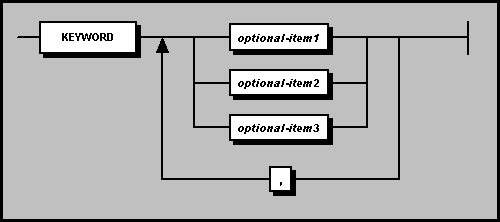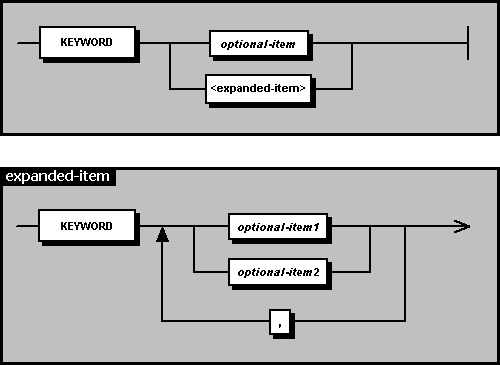The following conventions are used in the syntax diagrams:
- UPPERCASE letters indicate keywords (for example, INSERT).
Keywords must be spelled exactly as presented, but are not case-sensitive,
except where noted.
- Italicized words represent variables or arguments
(for example, table-name.column-name) for which the user must substitute
database object names or data values. In usage, these are only case-sensitive
where specifically indicated.
- Non-italicized words or phrases between angle brackets
( < > ) indicate that the syntax is expanded in a subsequent diagram
labeled with the same word or phrase. When uppercase keywords are followed
by the word �statement� (for example, <SELECT statement>), the syntax
element is another SQL command statement entirely, and should be replaced
by the appropriate syntax diagram.
- Partial diagrams are labeled with a word or phrase in
the upper-left corner. These named diagrams should be substituted for the
word or phrase wherever it is referenced in another syntax diagram.
- Parentheses ( ) appearing within the statement
syntax are part of the syntax, and must be typed as shown. Punctuation marks
such as commas ( , ) and colons ( : ) must be entered literally
wherever they appear in syntax diagrams. Mathematical symbols, such as plus
signs ( + ) and multiplication operators ( * ), must also
be entered literally.
- Underlined items indicate a default option. For example, if the options for SELECT are ALL and DISTINCT, SELECT by itself is the equivalent of SELECT ALL.
Required elements such as invocation commands and required arguments appear on the main path of the syntax diagram. A vertical bar signals the end of the syntax diagram, whereas an arrow signals continuation.

Optional elements appear below the main path of the syntax diagram.

If there are multiple choices for a required element, one
of the elements will be displayed on the main path of the diagram.

An arrow appears below a syntax element (or list of optional elements) when more than one element may be entered or when a particular element may be repeated. If the elements in the list must be separated by commas, a comma is shown in the syntax box.

Elements that are expanded in a subsequent syntax diagram are labeled with a word or phrase between angle brackets. The partial diagram that expands the element is labeled in the top left corner with the same word or phrase found between angle brackets in the preceding diagram.

Usage examples at the end of each statement description are shown in SAND CDBMS Interactive SQL. In SAND CDBMS Interactive SQL, statements must be terminated with a semicolon ( ; ).